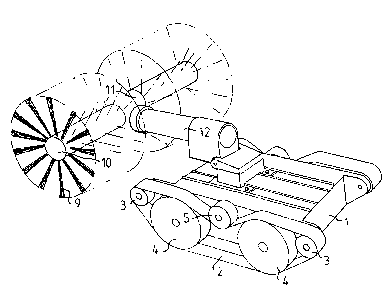Some of the information on this Web page has been provided by external sources. The Government of Canada is not responsible for the accuracy, reliability or currency of the information supplied by external sources. Users wishing to rely upon this information should consult directly with the source of the information. Content provided by external sources is not subject to official languages, privacy and accessibility requirements.
Any discrepancies in the text and image of the Claims and Abstract are due to differing posting times. Text of the Claims and Abstract are posted:
| (12) Patent: | (11) CA 2115753 |
|---|---|
| (54) English Title: | DEVICE FOR INTERNAL CLEANING AND/OR TREATMENT OF LONG CLOSED CHANNELS |
| (54) French Title: | DISPOSITIF POUR LE NETTOYAGE INTERNE OU LE TRAITEMENT DE PROFILE LONGS, FERMES |
| Status: | Expired and beyond the Period of Reversal |
| (51) International Patent Classification (IPC): |
|
|---|---|
| (72) Inventors : |
|
| (73) Owners : |
|
| (71) Applicants : |
|
| (74) Agent: | GOWLING WLG (CANADA) LLP |
| (74) Associate agent: | |
| (45) Issued: | 2003-04-29 |
| (86) PCT Filing Date: | 1992-02-11 |
| (87) Open to Public Inspection: | 1993-03-04 |
| Examination requested: | 1997-12-17 |
| Availability of licence: | N/A |
| Dedicated to the Public: | N/A |
| (25) Language of filing: | English |
| Patent Cooperation Treaty (PCT): | Yes |
|---|---|
| (86) PCT Filing Number: | PCT/SE1992/000082 |
| (87) International Publication Number: | WO 1993003866 |
| (85) National Entry: | 1994-02-15 |
| (30) Application Priority Data: | ||||||
|---|---|---|---|---|---|---|
|
The invention relates to a device for cleaning and/or treating elongated
closed ducts or channels, particularly ventilation
ducts. The device includes an automotive vehicle (1) and a cleaning and/or
surface treating unit (6) mounted on the vehicle. Also
mounted on the vehicle (1) is a TV-camera (16) or some corresponding device
for monitoring the result of a cleaning and/or treat-
ing operation.
Note: Claims are shown in the official language in which they were submitted.
Note: Descriptions are shown in the official language in which they were submitted.

2024-08-01:As part of the Next Generation Patents (NGP) transition, the Canadian Patents Database (CPD) now contains a more detailed Event History, which replicates the Event Log of our new back-office solution.
Please note that "Inactive:" events refers to events no longer in use in our new back-office solution.
For a clearer understanding of the status of the application/patent presented on this page, the site Disclaimer , as well as the definitions for Patent , Event History , Maintenance Fee and Payment History should be consulted.
| Description | Date |
|---|---|
| Time Limit for Reversal Expired | 2005-02-11 |
| Letter Sent | 2004-02-11 |
| Grant by Issuance | 2003-04-29 |
| Inactive: Cover page published | 2003-04-28 |
| Inactive: Final fee received | 2002-11-21 |
| Pre-grant | 2002-11-21 |
| Notice of Allowance is Issued | 2002-05-27 |
| Letter Sent | 2002-05-27 |
| Notice of Allowance is Issued | 2002-05-27 |
| Inactive: Approved for allowance (AFA) | 2002-05-10 |
| Inactive: Entity size changed | 2002-02-28 |
| Letter Sent | 2001-11-13 |
| Reinstatement Requirements Deemed Compliant for All Abandonment Reasons | 2001-10-25 |
| Reinstatement Request Received | 2001-10-25 |
| Reinstatement Requirements Deemed Compliant for All Abandonment Reasons | 2001-08-23 |
| Inactive: Abandoned - No reply to s.30(2) Rules requisition | 2001-05-14 |
| Deemed Abandoned - Failure to Respond to Maintenance Fee Notice | 2001-02-12 |
| Inactive: S.30(2) Rules - Examiner requisition | 2000-11-14 |
| Inactive: Status info is complete as of Log entry date | 1998-03-18 |
| Inactive: RFE acknowledged - Prior art enquiry | 1998-03-18 |
| Inactive: Application prosecuted on TS as of Log entry date | 1998-03-18 |
| All Requirements for Examination Determined Compliant | 1997-12-17 |
| Request for Examination Requirements Determined Compliant | 1997-12-17 |
| Application Published (Open to Public Inspection) | 1993-03-04 |
| Abandonment Date | Reason | Reinstatement Date |
|---|---|---|
| 2001-10-25 | ||
| 2001-02-12 |
The last payment was received on 2003-02-10
Note : If the full payment has not been received on or before the date indicated, a further fee may be required which may be one of the following
Please refer to the CIPO Patent Fees web page to see all current fee amounts.
| Fee Type | Anniversary Year | Due Date | Paid Date |
|---|---|---|---|
| Request for examination - small | 1997-12-17 | ||
| MF (application, 6th anniv.) - small | 06 | 1998-02-11 | 1998-01-26 |
| MF (application, 7th anniv.) - small | 07 | 1999-02-11 | 1999-01-11 |
| MF (application, 8th anniv.) - small | 08 | 2000-02-11 | 2000-02-11 |
| MF (application, 9th anniv.) - small | 09 | 2001-02-12 | 2001-08-23 |
| Reinstatement | 2001-08-23 | ||
| Reinstatement | 2001-10-25 | ||
| MF (application, 10th anniv.) - standard | 10 | 2002-02-11 | 2002-02-11 |
| Final fee - standard | 2002-11-21 | ||
| MF (application, 11th anniv.) - standard | 11 | 2003-02-11 | 2003-02-10 |
Note: Records showing the ownership history in alphabetical order.
| Current Owners on Record |
|---|
| SVEN ERIKSSON |
| Past Owners on Record |
|---|
| None |